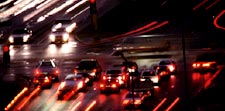
| Skip to Content |
|
 |
|
Reducing Non-Recurring Congestion Non-recurring congestion includes the development and deployment of strategies designed to mitigate traffic congestion due to non-recurring causes, such as crashes, disabled vehicles, work zones, adverse weather events, and planned special events. About half of congestion is caused by temporary disruptions that take away part of the roadway from use – or "nonrecurring" congestion. The three main causes of nonrecurring congestion are: incidents ranging from a flat tire to an overturned hazardous material truck (25 percent of congestion), work zones (10 percent of congestion), and weather (15 percent of congestion). Nonrecurring events dramatically reduce the available capacity and reliability of the entire transportation system. This is the type of congestion that surprises us. We plan for a trip of 20 minutes and we experience a trip of 40 minutes. Travelers and shippers are especially sensitive to the unanticipated disruptions to tightly scheduled personal activities and manufacturing distribution procedures. Aggressive management of temporary disruptions, such as incidents, work zones, weather, and special events can reduce the impacts of these disruptions and return the system to "full capacity." |
||
| US DOT Home | FHWA Home | Operations Home | Privacy Policy | ||